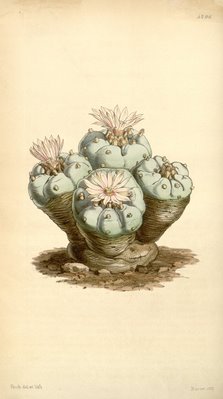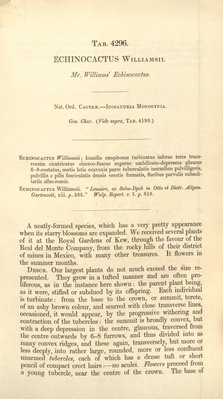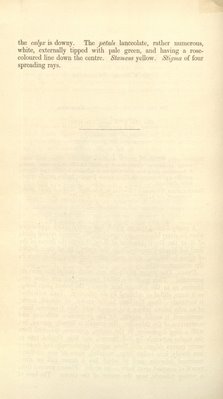 Since my early days as a “Lophophora aficionado” I’ve heard and read that the first illustration of Lophophora williamsii appeared in Curtis’s Botanical Magazine in 1847 (plate 4296). This fact seems to be very well known – probably because of Anderson’s book Peyote, The Divine Cactus – nevertheless it’s been next to impossible to find a good reproduction of the illustration.
Since my early days as a “Lophophora aficionado” I’ve heard and read that the first illustration of Lophophora williamsii appeared in Curtis’s Botanical Magazine in 1847 (plate 4296). This fact seems to be very well known – probably because of Anderson’s book Peyote, The Divine Cactus – nevertheless it’s been next to impossible to find a good reproduction of the illustration.
These days are over. The Botanicus Digital Library has scanned the material and made it available online. Below you’ll find copies of the scanned illustration as well as the accompanying description; the description is also reproduced in textual form.
ECHINOCACTUS WILLIAMSII.
Mr. Williams' Echinocactus.
_____________
Nat. Ord. CACTEAE.- ICOSANDRIA MONOGYNIA.
Gen. Char. (Vide supra, TAB. 4190.)
_____________________________
ECHINOCACTUS Williamsii ; humilis caespitosus turbinatus inferne teres transversim cicatricatus cinereo-fuscus superne umbilicato-depressus glaucus 6-8-costatus, costis latis convexis parce tuberculatis inermibus pulvilligeris, pulvillis e pilis fasciculatis densis erectis formatis, floribus parvulis subsolitariis albo-roseis.
ECHINOCACTUS Williamsii. “Lemaire, ex Salm-Dyck in Otto et Dietr. Allgem. Gartenzeit, xiii. p. 385.” Walp. Repert. V. 5. p. 816.
A neatly-formed species, which has a very pretty appearance when its starry blossoms are expanded. We received several plants of it at the Royal Gardens of Kew, through the favour of the Real del Monte Company, from the rocky hills of their district of mines in Mexico, with many other treasures. It flowers in the summer months.
DESCR. Our largest plants do not much exceed the size represented. They grow in a tufted manner and are often proliferous, as in the instance here shown: the parent plant being, as it were, stifled or subdued by its offspring. Each individual is turbinate: from the base to the crown, or summit, terete, of an ashy brown colour, and scarred with close transverse lines, occasioned, it would appear, by the progressive withering and contraction of the tubercles: the summit is broadly convex, but with a deep depression in the centre, glaucous, traversed from the centre outwards by 6-8 furrows, and thus divided into as many convex ridges, and these again, transversely, but more or less deeply, into rather large, rounded, more or less confluent unarmed tubercles, each of which has a dense tuft or short pencil of compact erect hairs:--no aculei. Flowers proceed from a young tubercle, near the centre of the crown. The base of the calyx is downy. The petals lanceolate, rather numerous, white, externally tipped with pale green, and having a rose-coloured line down the centre. Stamens yellow. Stigma of four spreading rays.



The scans are courtesy of the Botanicus Digital Library, Missouri Botanical Garden and are free for non-commercial use, as long as attribution is provided.
High-resolution copies of the scans can be found in the files section of the Lophophora Google group.
Back to online articles.


















